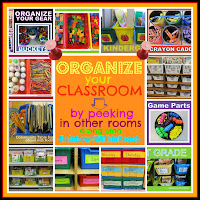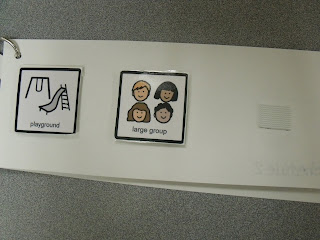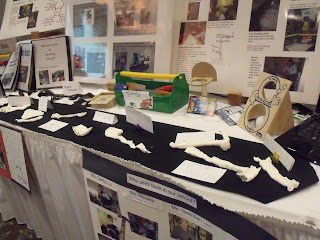Here's a VERY quick and easy organizing idea I have used for a while in my teeny, tiny classroom! No...really, my space is very limited in my classroom! (I know...I know, I'm not the only one!) I basically have a small corner of the classroom devoted to my desk and 2 shelves devoted to resource books and binders to organize all my information and paperwork!
However, I often run out of space for all of the binders and books I have here. I was constantly taking a binder down then accidentally putting it on another shelf! Because of this, NOTHING would fit correctly...and I was, yet again, out of space.
So I came up with a very quick way to make sure that I don't run out of space because I am unknowingly rearranging! Basically, I've attached a colored sticker to my resource books and binders. Red for the binders that belong on my desk, blue for the resource books and binders that fit on my shelf and yellow for the books and binders that belong on my large wooden shelf!
This may seems silly, but it's worked for me! When I start a new binder or add a resource book, I find a shelf that it will fit on and slap on a sticker! This way, I know it definitely fit on a shelf at SOME point...so it's POSSIBLE to find a space to put it back on the shelf! So, if you also are space-deprived and need to make sure there is space for books and binders, feel free to give this a try! It won't make your classroom grow...but at least it will keep you from feeling like you are losing your mind!
If you would like more ideas on organizing, I've written just a few times about things I have organized. :) So feel free to head over to: Organizing All our Stuff...Part I, Part II, Part III, Part IV and Part V.
(For full disclosure: I don't remember reading about this tip anywhere...but it's been sitting in my draft posts for so long that I can't be sure about this! Please let me know if you've seen this tip out there somewhere so I can provide a link!)
**This post is linked to Rainbows Within Reach classroom organization linkie!

However, I often run out of space for all of the binders and books I have here. I was constantly taking a binder down then accidentally putting it on another shelf! Because of this, NOTHING would fit correctly...and I was, yet again, out of space.
So I came up with a very quick way to make sure that I don't run out of space because I am unknowingly rearranging! Basically, I've attached a colored sticker to my resource books and binders. Red for the binders that belong on my desk, blue for the resource books and binders that fit on my shelf and yellow for the books and binders that belong on my large wooden shelf!
This may seems silly, but it's worked for me! When I start a new binder or add a resource book, I find a shelf that it will fit on and slap on a sticker! This way, I know it definitely fit on a shelf at SOME point...so it's POSSIBLE to find a space to put it back on the shelf! So, if you also are space-deprived and need to make sure there is space for books and binders, feel free to give this a try! It won't make your classroom grow...but at least it will keep you from feeling like you are losing your mind!
If you would like more ideas on organizing, I've written just a few times about things I have organized. :) So feel free to head over to: Organizing All our Stuff...Part I, Part II, Part III, Part IV and Part V.
(For full disclosure: I don't remember reading about this tip anywhere...but it's been sitting in my draft posts for so long that I can't be sure about this! Please let me know if you've seen this tip out there somewhere so I can provide a link!)
**This post is linked to Rainbows Within Reach classroom organization linkie!







































